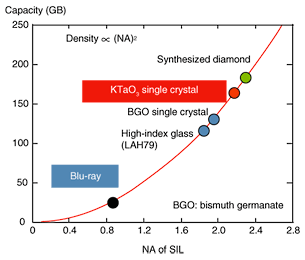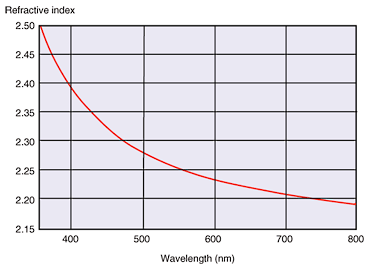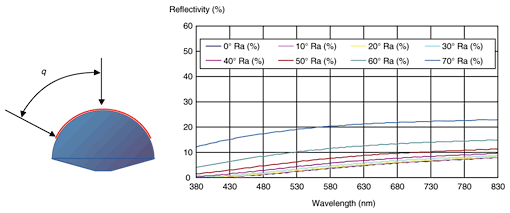 |
|||||||||||||||||
|
|
|||||||||||||||||
Vol. 5, No. 9, pp. 26–30, Sept. 2007. https://doi.org/10.53829/ntr200709sp4 KTaO3 Solid Immersion Lens for Near-field Optical Disk SystemAbstractWe have developed KTaO3 single crystal growth and solid immersion lens (SIL) fabrication technologies for a near-field optical disk system. KTaO3 has a refractive index of 2.381 at 405 nm, which makes it possible to make an SIL with a high numerical aperture. We fabricated a KTaO3 SIL with an anti-reflection coating on its surface. High-density near-field optical readout of a 150-GB disk (104.3 Gbit/in2) has been successfully demonstrated by Sony Corporation using an SIL made of our KTaO3 single crystal.
1. IntroductionSeveral optical data storage technologies have been proposed with a view to making a next-generation optical disk system for applications related to high-definition television. Of these, near-field optical disk technology with a capacity of over 50 GB has already been reported [1], [2]. To increase the capacity further, we must develop a solid immersion lens (SIL) with a higher numerical aperture (NA). This requires a material with a higher refractive index. An SIL has a higher numerical aperture than common lenses because the object space*1 is filled with a high-refractive-index solid material and its spot size is λ/n sinθ. By using an SIL, we can achieve a spatial resolution better than the diffraction limit in air. Up to now, high-refractive-index glasses, s-LAH79 and LaSF35, and a Bi4Ge3O12 single crystal have been investigated as materials for an SIL. These materials have relatively high refractive indices compared with conventional optical glasses, but they are lower than 2.25. In the case of a super-hemisphere*2 SIL, the disk capacity is quadratically proportional to the NA of the SIL. Therefore, a material having a higher refractive index is better for the next-generation optical disk system. A synthesized diamond has been used for the SIL and 190-GB disk readout has been demonstrated [3]. Diamond has an extremely high refractive index, but its hardness makes it difficult to fabricate a high-quality SIL in terms of sphericity. In this paper, we describe the development of KTaO3 single crystal with a refractive index of over 2.38 and a KTaO3 SIL with practical optical quality.
2. KTaO3 single crystalDisk capacity is quadratically proportional to the NA of the SIL, as shown in Fig. 1. Single-crystalline materials are required for the SIL because the refractive indices of glass materials are insufficient for a disk capacity of over 100 GB. In addition, an SIL requires extremely high optical homogeneity, so the crystals should exhibit no birefringence.
We have developed the KTaO3 single crystal and its growth technology to meet the above demands, thus enabling us to produce a high-quality lens material applicable to SILs. The refractive index of KTaO3 crystal in the visible region is shown in Fig. 2. The absorption cutoff wavelength is around 365 nm and KTaO3 has relatively high refractive index dispersion. The refractive index is 2.381 at a reading/writing laser wavelength of 405 nm. This is higher than that of high-refractive-index glasses such as s-LAH78 and LaSF35, but slightly smaller than that of diamond. We also confirmed that the fluctuation in the birefringence in the KTaO3 crystal is sufficiently small to meet the SIL specifications.
In addition to these optical properties, we require excellent mechanical properties. Even though KTaO3 is a single crystal, it is resistant to cleavage. This means that the chipping does not occur during polishing. Moreover, the hardness of KTaO3 is almost isotropic. Therefore, we can treat this crystal just like glass, and of course we can use the same polishing techniques as those used for optical glasses. This enables us to undertake commercial production without the development of any additional polishing technology. 3. SIL fabrication processThe SIL fabrication process is shown in Fig. 3. First, we grow a KTaO3 single crystal by using the top seeded solution growth technique. Then, KTaO3 crystal is cut into plates and both surfaces are polished to allow us to evaluate the optical quality. After eliminating any defects, we cut the plates into cubes and then fabricate ball lenses by polishing. This process is exactly the same as that used for glass ball lenses. We then fabricate SILs with a cone shape. The cone shape is designed to accommodate tilt between the SIL and the disk surface. Finally, the lens surfaces are covered with an anti-reflection coating.
3.1 Quality evaluation of KTaO3 crystalDuring the above process, we eliminated regions with refractive index fluctuation caused by internal stress during the crystal fabrication by using a polarized microscope and a birefringence apparatus. After cutting the KTaO3 crystal into plates and polishing both surfaces, we measured the birefringence distribution in the plates in a 1-mm2 area. The criterion for practical use was defined as having birefringence of less than 1 × 10−6 for a thickness of 1 mm [4]. 3.2 KTaO3 ball lens fabricationBall lenses obtained by polishing the prepared KTaO3 crystal are shown in Fig. 4. Since KTaO3 has excellent machinability, we can use the well-established conventional glass ball lens fabrication technique. This enables us to obtain excellent sphericity and surface roughness. In terms of dimensional accuracy, we have obtained sphericity of better than 0.05 µm (a deviation from the target diameter of less than 0.05 µm) and a surface roughness Ra of less than 0.2 µm for a KTaO3 ball with a diameter of 1 mm. These accuracies are better than those of commercial ball lenses.
3.3 KTaO3-SIL fabricationAfter fabricating a KTaO3 ball lens, we polish one side of it to obtain a super-hemisphere or hemisphere with a thickness accuracy of better than 0.1 µm. Then we form a conical shape by polishing. The hemispherical KTaO3 lenses are individually polished into a cone shape. An SIL that we fabricated and the dimensional shape measured with an interferometer (Zygo Corporation) are shown in Figs. 5 and 6, respectively. In this case, the top radius facing the optical disk surface was 25 µm. There was no chipping around the edge. The decentering accuracy was better than 5 µm.
Finally, we prepare an anti-reflection coating on the SIL surface. We can deposit both an SiO2 single layer and a dielectric multilayer with good adhesion and achieve a homogenous thickness in the region where in angle of incidence is more than 60° from normal incidence. Simulation results for the wavelength-dependence of the reflectivity for various incidence angles are shown in Fig. 7. In this simulation, the wavelength was 405 nm and the coating was an SiO2 single layer. The results reveal that reflectivity of less than 5% can be achieved by using an SiO2 single-layer coating.
4. Near-field readout experimentThe NA of the KTaO3-SIL was designed to be 2.2. A near-field readout experiment with a 150-GB optical disk, corresponding to a density of 104.3 Gbit/in2, was performed by Sony Corporation [4]. The results indicate that our KTaO3 crystal has sufficient optical quality for use as the SIL of a near-field optical disk system. 5. ConclusionWe developed KTaO3 single crystal and a solid immersion lens made of it for a near-field optical disk system. KTaO3 has a high refractive index at a reading/writing laser wavelength of 405 nm. We prepared an SIL with practical optical quality, which was confirmed by near-field readout experiments with a 150-GB disk. We think that the KTaO3-SIL is a promising component for a next-generation optical disk system. References
|
|||||||||||||||||
















